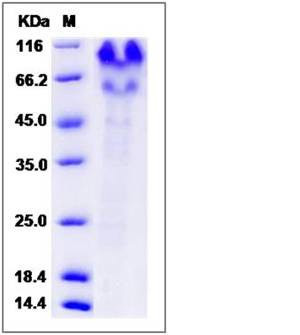Human PSGL-1 / CD162 / SELPLG Protein (His Tag)
CD162,CLA,PSGL-1,PSGL1
- 100ug (NPP2440) Please inquiry
| Catalog Number | P13863-H08H |
|---|---|
| Organism Species | Human |
| Host | Human Cells |
| Synonyms | CD162,CLA,PSGL-1,PSGL1 |
| Molecular Weight | The recombinant human SELPLG comprises 289 amino acids and has a predicted molecular mass of 30.5 kDa. The apparent molecular mass of the protein is approximately 89 and 61 kDa in SDS-PAGE under reducing conditions. |
| predicted N | Leu 18 |
| SDS-PAGE |  |
| Purity | (82+15.2) % as determined by SDS-PAGE |
| Protein Construction | A DNA sequence encoding the human SELPLG (Q14242) (Met1-Gly295) with a C-terminal polyhistidine tag was expressed. |
| Bio-activity | |
| Research Area | Immunology |Innate Immunity |Granulocyte Markers |
| Formulation | Lyophilized from sterile PBS, pH 7.4. 1. Normally 5 % - 8 % trehalose and mannitol are added as protectants before lyophilization. Specific concentrations are included in the hardcopy of COA. |
| Background | P-selectin glycoprotein ligand-1 (PSGL-1), also known as SELPLG or CD162, is the high affinitycounter-receptor for P-selectin on expressed on activated endothelial cells and platelets. PSGL-1 is a mucin-type glycoprotein, expressed on leukocytes and platelets as a homodimer of two disulfide-linked subunits of ~120 kD. As cell adhesion molecules, multiple studies have shown that PSGL-1/ P-selectin interaction is required for the normal recruitment of leukocytes during inflammatory reactions, and also participates in hemostatic responses. PSGL-1 protein requires two distinct posttranslational modifications for the Ca2+-dependent recognition by the lectin domain of P-selectin, that is tyrosine sulfation and specific O-linked glycosylation (sialic acid and fucose). PSGL-1 can also bind to other two members of the selectin family, E-selectin (endothelial) and L-selectin (leukocyte), but binds best to P-selectin. |
| Reference | 1. Sako, D. et al., 1993, Cell. 75: 1179-1186. 2. Wilkins, P. P. et al., 1995, J. Biol. Chem. 270: 22677-22680. 3. Frenette, P. S. et al., 2000, J. Exp. Med. 191: 1413-1422. 4. Vandendries, E.R .et al., 2004, Thromb. Haemost. 92: 459-466.. 5. Pouyani, T. et al., 1995, Cell. 83: 333-343. |
